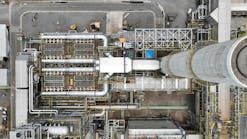Phillips 66 advances plans for splitter at Sweeny refinery
Phillips 66 has filed an application with state regulators for a permit to build a condensate splitter at its 247,000-b/d Sweeny refinery in Old Ocean, Tex. (OGJ Online, Mar. 21, 2014).
The permit application for a “simplified condensate splitter unit” was filed with the Texas Commission on Environmental Quality (TCEQ) on Dec. 5, according to information recently made available on TCEQ’s web site.
The move comes as part of the company’s strategy to leverage its substantial existing assets at the US Gulf Coast as continues to grow its midstream business to meet growing demand for domestic crude oil and global market demand for US-supplied products, Phillips 66 spokesman Dennis Nuss told OGJ.
“The company is evaluating condensate splitter options to meet customer demands,” Nuss said, adding that a final decision on condensate processing will be made in 2015.
While Phillips 66 confirmed in March that preliminary engineering and economic analysis for the condensate splitter as well as a second fractionator in the Sweeny area already was under way, the company also is evaluating a crude oil and condensate pipeline, Nuss said.
The proposed 110,000-b/d Sweeny Fractionator 2 may be built near the Sweeny refinery and Sweeny Fractionator 1, while the crude and condensate pipeline will connect Eagle Ford production to the Sweeny refinery and Phillips 66’s terminal in Freeport, Tex.
“The projects are currently in the engineering design and permitting phase,” Nuss said.
The company plans to reach final approval for the second fractionator and crude and condensate pipeline during mid-2015.
If approved, start-up of the pipeline is planned for late 2016, with the second fractionator at Sweeny slated for start-up in 2017, Nuss said.
Phillip 66’s plans to add additional splitting and fractionating capabilities to expand midstream growth come as US Gulf Coast operators—which are mostly configured to run heavier, sour crude slates—seek to maximize profits and minimize losses from processing light tight oil from surging North American shale production.
